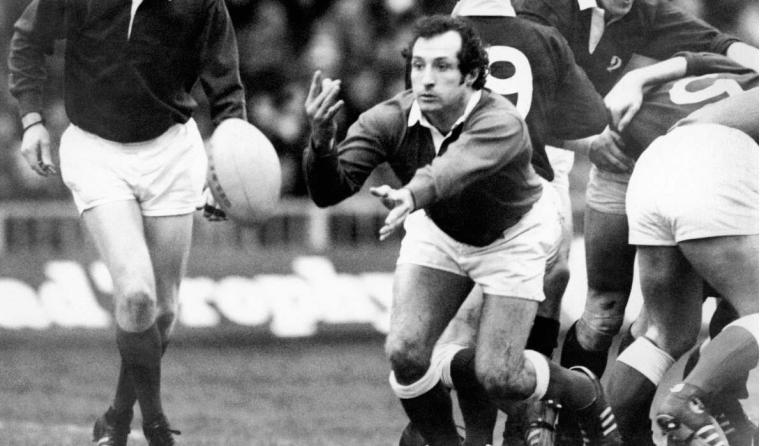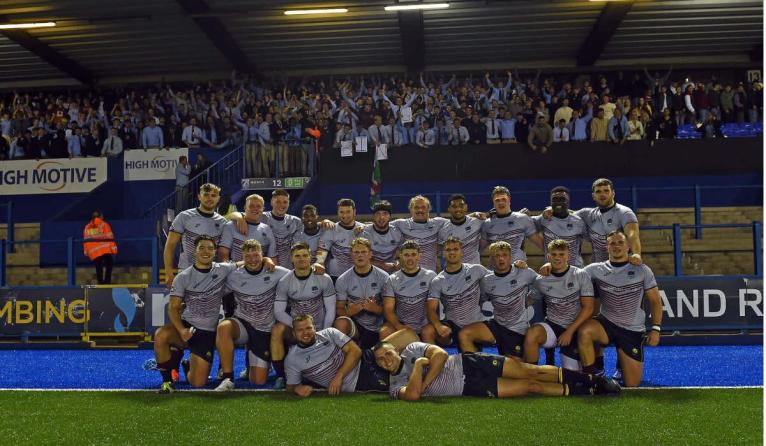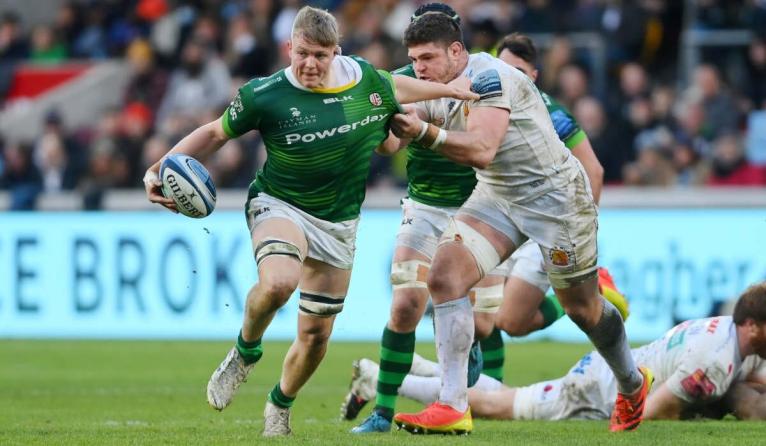“Cardiff Metropolitan University seems to be a popular breeding ground for test match rugby players. Dombrandt caroused the bars there for a while, and now Northmore’s similarly out of there. He runs strong lines, carries well through contact and has got good footwork.”
The sage words of England coach Eddie Jones, helping to shine a light on an institution that’s enjoying a burgeoning reputation for discovering and nurturing elite talent. It wasn’t a huge revelation. The so-called “College of Knowledge” has a distinguished history of developing world-class athletes. Clive Rowlands, JJ Williams, Roy Bergiers, Allan Martin, Brynmor Williams, John Devereux, and Ryan Jones are all former alumni. So too is perhaps the greatest of all time, Sir Gareth Edwards. But the glare of the world’s media has intensified in recent weeks after a second recent graduate was named in England’s international squad. Luke Northmore arrived at Cardiff Met in 2015 with the fairly modest aim of getting a degree in Sport and PE and turning out for the seconds or thirds. Less than seven years later, he’s preparing for the world’s biggest annual rugby tournament. It is, by any reckoning, a remarkable rise.
His Harlequins colleague, Alex Dombrandt, followed a similarly circuitous path to the top. An overweight, cake-loving cricketer, Dombrandt arrived at Cardiff Met eager to embrace the full University experience. Under the guidance of a coaching group that clearly appreciates the balance between athletic endeavour and academic progress, he graduated with a 2:1 before signing for Harlequins who knew they’d acquired a rare talent: an instinctive, attack-minded player with the build of a No 8, and the vision of a fly-half. “Alex stood out straight away” says Dr Ian Gardner, Cardiff Met’s Head Coach. “He’s the best attacking forward I’ve ever coached. I’ve never seen anything like his anticipation.”
Gardner, a grizzled former forward, coached Wales at age-grade level and spent years at the helm of Bedwas in the Welsh Premiership. He’s one of several coaches who look after the top 50 players in the University – the “elite” squad that competes in the BUCS Super Rugby League, and the Welsh Championship. The project is overseen by the genial Danny Milton, and they’re assisted by former Newport prop Alun Williams. Together they form an engaging trio, colleagues who clearly get on well and never miss an opportunity to puncture each other’s egos. When Milton casually name drops Quins head coach, Tabai Matson, Gardner smirks and says “ohh, rugby friend”. When Milton outlines the different pressures he faces compared to academy coaches attached to the Welsh regions, saying, “I’m not going to get fired if we lose to Northumbria tonight”, Gardner immediately deadpans “you ****ing might be, butt”. Later, when discussing the roll-call of famous names that have passed through the university, Milton innocently asks Gardner, several years his senior, if he’d been in the same year as Gareth. “Gareth Cooper?” Gardner enquires. “No, Edwards” came the stinging rebuke.

Milton took over as director of rugby in 2017, taking the reins of what was already a progressive rugby programme. “There’s a huge history going back to Gareth Edwards, and I’m so fortunate to have the opportunity to work here because of that” he says. His priority,“was to create a more holistic environment so that Cardiff Met wasn’t seen as an easy option, and that you could genuinely get a good degree out of it.” Returning to his point about not getting sacked after a bad result on the field, he insists their “key performance outcomes are as much about our academic degrees as about sporting excellence, so we can afford to look at things differently.”
At a time when rugby participation levels in a post-covid Wales are continuing to decline, Cardiff Met represents a significant outlier. In a student body of around 15,000, they have more than 300 rugby players. That’s enough to put out twelve teams a week. Gardner is clearly astonished at the sheer strength in numbers, claiming “when I was in Bedwas you were bloody happy if you had more than 20 in training” with a shake of his head. My visit coincided with a Wednesday night fixture against Northumbria in the BUCS Super League. Seven teams had fixtures that day, and five more had played over the weekend. The fifty best players are the ones who play in Super Rugby and the Welsh Championship. While the rugby department doesn’t have a huge budget, these players have access to a comprehensive strength-and-conditioning programme, performances analysts, and sports psychologists as well as massage and physio support. Most of this support is provided by students or interns studying in the relevant areas, and mirrors the set up at most professional clubs.
The performance analysts are all 3rd year students gaining valuable experience in their chosen profession. Above the pitch ahead of that night’s fixtures, more than a dozen students are positioned at their laptops ready to log, analyse and code every second of the action. “Since I joined in 2008” says Milton, “every year they’ve gone into a professional environment, so there isn’t a rugby club in the UK that doesn’t have a Cardiff Met analyst attached to them”. Among those are Rhodri Bown, the WRU’s head of performance analysis, and Jonny Gardener, one of several unsung heroes at the world’s best club side, Canterbury Crusaders. “The boys – whether or not they realise it – are pretty well catered for” says Milton surveying the state-of-the-art facilities. “If they don’t go on to the professional game and go back to their Maesteg Harlequins or wherever, it’s going to be a bit of a shock to the system!”
Scott Baldwin, the former Wales hooker and an erstwhile colleague of Alex Dombrandt at Quins, once joked in these pages that if Dombrandt had paid council tax while living in Cardiff, he could have qualified for Wales on residency. It’s a moot point, as Dombrandt is English born-and-bred and has been unequivocal about where his allegiances lie. But it hasn’t prevented howls of outrage from the Welsh rugby heartlands about why English clubs are signing up promising youngsters from a university in the Welsh capital.

It’s led to accusations that the lens of the WRU and the four regions is too narrow. With their focus on the academies they fund, and to a lesser extent the Welsh Premiership, they’re potentially ignoring a vital link in the supply chain. It’s a debate that grinds Milton’s gears. “There’s this narrative in the media where we have to be in competition (with the regions and the WRU) and I’m fed up with it” he says. “We should be seen as something complementary and alternative. Rugby’s a long-term athlete development sport, and not everybody is ready at 17/18. Some of them are, granted. Louis Rees-Zammit for example. But Luke and Alex took a little longer. Alex has a great cricket background. All those other things he’s learnt from being a multi-sport athlete have given him a different view of the game. (Former Wales and Lions hooker) Matthew Rees, who’s his agent, told me recently that the benefit of these university kids is that they offer something different, they’re more rounded. We should be used as an alternative for guys who maybe aren’t ready, or are on a different pathway. Let’s stop making this a competition.”
Gardner develops the theme: “twelve months ago there was a really strong feeling among the Welsh regions of, ‘I’m not really sure about this BUCS Super Rugby and I’m not really sure about Cardiff Met’, but in the last 12 months the sands have begun to shift. Ellis (Bevan) going to Cardiff Rugby has helped with that, as has Dombrandt becoming a poster boy of English rugby. Then Tom Pearson (at London Irish) and of course, Luke. So it’s no surprise that some of the regional academy managers have started saying, ‘look guys, we’re really impressed with this BUCS Super Rugby and I can see the value in it.’ Through people like Dai Rees at the Dragons academy and Gruff Rees at Cardiff our relationships have become much better.”

Gardner also suggests the attitude among some of the regional bureaucrats was that there was no point mining the university sides for talent because they were playing at a level beneath that of the Welsh Premiership. “I coached Welsh Premiership for years and it’s not the quality product it once was. Despite that there was still a feeling from the regions of ‘hang about, Cardiff Met wouldn’t beat Cardiff, they wouldn’t beat Merthyr, they wouldn’t beat Newport, so those players are not as good as what we’ve got there. That’s not how it should be perceived,” he continues. “Quite right, we wouldn’t beat those teams because our boys are 19,20,21 at the oldest. They’re still very young, but you take two or three of them – the Alexes and the Lukes – you put them in a Cardiff RFC side, and they’d tear up. I think they’re starting to realise it’s not just about the collective XV. If we can take these nuggets out of there and drop one or two of them into a more experienced team, it’s a different ball game.”
When Dombrandt started making headlines for his exploits at Quins, the former Wales fly-half Jonathan Davies took to social media to question why Cardiff Rugby hadn’t been the first professional side to beat down his door. The suggestion was that he’d been ignored or overlooked. The truth was a little more nuanced. Cardiff’s head coach at the time was Danny Wilson, a former Cardiff Met student himself, and a personal friend of Milton’s. “We’re sat with Dombrandt after he’s completed his second year” remembers Milton. He did get offered a contract with Cardiff, so it wasn’t that they missed him, but it was like, ‘what will happen with his studies?’ Danny said ‘we’ll support him, but he has to be in for training every day.’ For us that didn’t quite marry up. Alex chose to stay and finish his degree and that’s because we encouraged him to. You’re only ever one serious injury from the end of a rugby career.”

Cardiff Met also runs a course specialising in sports broadcasting. It’s the brainchild of experienced TV producer, Joe Towns, who’s committed to training the next generation of sports reporters and presenters. Recognising a unique opportunity, he partnered up with several of the universities’ sports teams to produce reams of content for social media and the university’s own YouTube channel. It’s a mutually beneficial arrangement. The broadcast students have a veritable smorgasbord of sport to report on, and the teams get the kind of publicity that attracts interest well beyond the boundaries of its bustling campus. “To see what Joe’s doing with the sports broadcast course has become a USP for us,” enthuses Milton. “For someone like Dombrandt – the stuff they put on social media was probably what piqued some of that initial interest. What Cardiff Met Sport TV has done has been phenomenal.”
Another vital member of the Cardiff Met team is Strength-and-Conditioning Coach, Dai Watts. A chiselled, granite-boned man who clearly practices what he preaches. Virtually everyone you speak to namechecks Dai at some point, and his influence is clearly strong. When Dombrandt first started playing for Quins, his “uni rig” was a source of mirth for several of his colleagues who liked to tease him that his student lifestyle and love of cakes had left him a bit soft around the edges. Dai breaks out a weary grin when I bring it up. “He was around 140kg at one point, and we brought him down to about 118. I went down to Quins and picked up on the comment someone made about him having a uni bod and I said ‘you should have seen him before!’” Danny Milton backs him up: “Dai doesn’t get the credit he deserves. People talk about Alex’s ‘university rig’. When he came here he was twice the size, twice the size. He was in terrible nick!” While Dombrandt cuts a leaner figure these days, Milton says he’s still the same laid-back, grounded student he always was. “After the Cardiff game (Cardiff vs Harlequins in the Heineken Cup), they came round here for breakfast and then stayed on to meet all their college friends in the night. Dommers is still driving his battered old Ford Fiesta, and he still hasn’t got curtains for his new house six months after moving in. He’s using his second pillow to keep the sun from coming in!”

With the scouts circling, and Eddie Jones providing some priceless publicity, plenty are wondering, who’s the next Alex Dombrandt or Luke Northmore. Following the captain’s run ahead of the Northumbria game, I grabbed a few minutes with two of the current crop’s most promising youngsters: Neath-born Iwan Shenton, a towering muscular Number 8, and Will Rigg, a rangy, powerful centre from Solihull. Iwan spent two years in the Ospreys academy before enrolling at Cardiff Met, whereas Will switched to rugby after a year playing cricket in Australia. Both have aspirations to play professional rugby, and have been inspired by the example shown by Dombrandt, Northmore and Tom Pearson. “I played in the back row with Tom”, Iwan explains. “So seeing him do what he’s done definitely makes you switch on a bit more, makes you train a bit harder.” “You see them doing it” adds Will, “and you realise the transition from what we’re doing now isn’t a million miles away, which is a credit to the programme we’re on. It just shows that we’re a lot closer to that pro level than we perhaps realised.”
Both agree that what makes the Cardiff Met experience unique is not only that you play far more games than you might in an academy set-up, but that you get exposed to two distinct types of rugby that are, in Shenton’s words, “polar opposites”. The two premier competitions the Archers play in are BUCS Super Rugby, and the WRU-run Welsh Championship (one tier beneath the semi-professional Premiership). The Championship contains some historic Welsh teams like Pontypool, Cross Keys, and Neath (who Shenton grew up supporting) comprised of grizzled veterans who enjoy nothing more than “roughing up” a bunch of students, “the majority of whom are probably English”, says Rigg, eliciting a sly grin from Shenton. Playing in that league, Shenton adds, is all about “proving yourself”. It’s a “test of what you’re made of” as a forward; less about showcasing your handling skills and running lines, more about standing up to a bunch of hard men intent on knocking your head off. “A lot of the boys played Trebanos at the weekend and there was a big bust up at the end” says Shenton. “Those who held there own were seen to have passed the test!”
While there’s an underlying humour, there is a darker side, with Dombrandt himself nearly giving up the sport after having his jaw broken twice in separate incidents while playing against Glynneath. BUCS Super Rugby by comparison is played at a higher tempo, with pace, precision and innovation more prized than physical dominance. The average ball-in-play time is 36 minutes, which can be a stark contrast, according to Shenton, to the more plodding experience of the Championship where “you’re walking from lineout to lineout, and sometimes you’re lucky if you get through more than a few phases.”
Within a few hours of our chat, the Archers had demolished Northumbria by 50 points to 12 in front of a raucous crowd of around 300, strengthening their assault on the playoffs. It was an impressive performance, with Shenton leading from the front with a series of powerful surges from the base of the scrum. Earlier that afternoon, two of his colleagues, Joe Cowell and Rhys Barratt had been told of their selection in Wales Six Nations U20s squad. It’s further evidence that Cardiff Met remains a valid pathway to international honours. Although based on the evidence witnessed by this writer, its students are more likely to be found lifting weights at 6.30 in the morning under the watch of Dai Watts, than carousing the bars of Cardiff. Students they may be, but before long they may be following in the footsteps of some of their esteemed predecessors, whether they can afford new curtains or not.


Comments
Join free and tell us what you really think!
Sign up for free